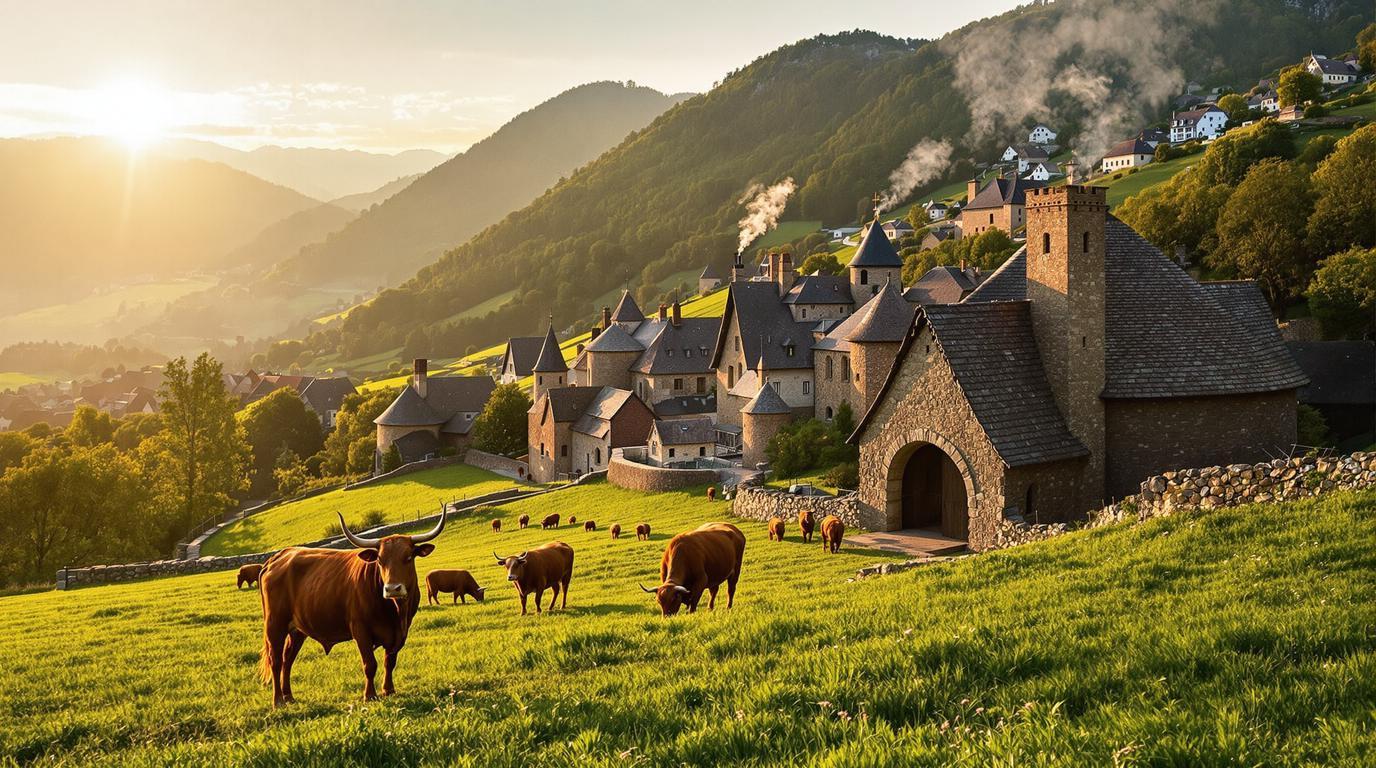Hidden in the volcanic heart of central France lies a medieval treasure that time forgot. Salers, a small village of black stone buildings in the Cantal department of Auvergne-Rhône-Alpes, has earned its place among the “Most Beautiful Villages of France” – and for good reason. While Paris draws millions, only the most discerning travelers discover this 900-meter-high volcanic plateau where history, gastronomy, and dramatic landscapes converge in perfect harmony.
A village carved from volcanic stone
Walking Salers’ narrow cobblestone streets feels like stepping through a portal to medieval France. The village’s distinctive architecture – built entirely from dark volcanic stone – creates a dramatic contrast against the lush green pastures surrounding it. These buildings, many dating back to the 15th and 16th centuries, feature ornate Renaissance doorways, mullioned windows, and turreted roofs that have weathered centuries of mountain storms.
“Our village represents a perfect fusion of nature and human craftsmanship,” explains Marie Durand, a local historian. “The volcanic stone that gives Salers its unique character was formed millions of years ago when the Cantal volcano – once taller than Mont Blanc – dominated this landscape.”
Where cows are crowned queens
No visit to Salers is complete without encountering its namesake cattle. The distinctive Salers breed – with their deep mahogany coats and elegant lyre-shaped horns – have grazed these volcanic plateaus for centuries. These hardy mountain cows produce milk for one of France’s most beloved cheeses, also called Salers, which holds coveted AOC (Appellation d’Origine Contrôlée) status.
For the most authentic cheese experience, visit during summer when local farmers still make cheese in traditional burons – small stone huts scattered across high mountain pastures where the age-old traditions of cheesemaking continue much as they have for generations.
A gastronomic playground of volcanic proportions
Salers’ culinary heritage extends far beyond its namesake cheese. The village serves as a launchpad for exploring Auvergnat cuisine – hearty mountain fare designed to fortify against harsh winters. Don’t leave without trying aligot, a silky, stretchy blend of mashed potatoes and Cantal cheese that pairs perfectly with the region’s robust charcuterie.
At La Cave de Salers in the village center, you can sample five protected AOC cheeses produced within a 30-mile radius – a dairy density unmatched almost anywhere in the world. Follow this with a trip to a local bistro for truffade, a golden potato pancake enriched with young Cantal cheese and crispy bacon.
Beyond the village walls
While Salers captivates, the surrounding landscapes demand exploration. The village serves as an excellent base for discovering the Cantal mountains – the eroded remains of Europe’s largest stratovolcano. Hikers can follow trails through beech forests and alpine meadows, while photographers will find endless inspiration in the rugged peaks and dramatic valleys.
Just a short drive away lies an alpine lake that mirrors jagged peaks – one of many natural wonders in this geologically fascinating region.
When time stands still
Unlike this medieval French village that has remained unchanged since 1306, Salers has evolved organically while preserving its essential character. Each stone building tells a story of volcanic fire, human ingenuity, and centuries of mountain life.
“What makes Salers special is how it remains authentically alive,” says Pierre Laurent, a local cheese producer. “We’re not a museum village – people still live and work here, continuing traditions that stretch back hundreds of years.”
A perfect day in Salers
Start your morning at the Esplanade de Barrouze for panoramic views across the Cantal mountains. Spend midday exploring the village’s narrow streets and Renaissance mansions before lunch at a local bistro. Afterward, visit the 15th-century Église Saint-Mathieu with its remarkable Gothic architecture before ending your day with a sunset walk along the ancient ramparts.
While many travelers rush to explore hidden Greek islands or car-free Croatian islands, Salers offers a distinctly French alternative to the Mediterranean – a place where volcanic drama meets medieval charm in a setting that has captivated travelers for centuries.
Unlike French tidal islands with limited access windows, Salers welcomes visitors year-round, though summer brings the village to life with markets, festivals, and the traditional movement of cattle to high mountain pastures – an ancient practice that continues to this day in this remarkable corner of volcanic France.
